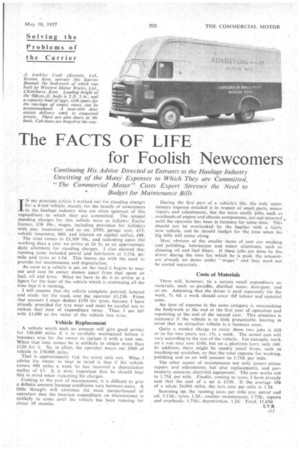The FACTS OF LIFE for Foolish Newcomers
Page 59

If you've noticed an error in this article please click here to report it so we can fix it.
• Continuing His. Advice Directed at Entrants to the Haulage Industry Unwitting of the Many; Expenses to Which They are Committed, "The Commercial Motor" ,Costs Expert Stresses the Need to -Budget for Maintenance Bills
IN my previous article I worked out the standing charges for a 6-ton vehicle, mainly for the benefit of newcomers to the haulage industry who are often ignorant of this expenditure to which they are committed. The annual standing charges for this vehicle were as follows: Excise licence, £38 10s.; wages, including provision for holidays with pay, insurances and So on, .£950; ,garage rent, £13: vehicle insurance, £60-, and interest on capital outlay, £48.
The total Comes to £1,109 10s., and reckoning upon 260 working days a year we arrive at £4 5s. as an approximate
daily allotment for standing charges. I also showed that running costs included petrol and lubricants at 5.I5d. per Mile and tyres at 1.5d. This leaves me with the need to provide for maintenance and depreciation. .
As soon as a vehicle is put on the road it begins to wear out and cost its owner money apart from that spent on fuel, oil and tyres. What we have to do is to arrive at a figure for the wear of the vehicle which is continuing all the time that it is running,
• I will assume that the vehicle complete. painted, lettered and ready for the road, cost the operator £1,230. -From that amount I must deduct £150 for tyres, because I have already provided for tyre wear and must be 'careful not to reckon that item of expenditure twice. Thus. I am left with £1,080 a§ the value of the vehicle less tyres.
Vehicle Replacement
A vehicle Worth such an amount will give good service for 150,000 miles if it is carefully maintained before it becomes wise for the owner to replace it with a new one. When that time comes he is unlikely to obtain more than £120 for it. So, in effect. the operator wears out £960 of vehicle in 150,000 miles.
That is approximately 14-d. for every mile run. What I advise the owner to bear in mind is that if his vehicle covers 480 miles a week he has incurred a depreciation outlay of £3. It is most important that he should bear this in mind when reckoning his charges.
Coming to the cost of maintenance, it is difficult to give a definite amount because conditions vary between users, A little thought will convince the most inexperienced of operators that the heaviest expenditure on maintenance is unlikely to come until the vehicle has been running for about 18 months.
During the first part of a vehicle's life, the only maintenance expense entailed is in respect of small parts, minor repairs and adjustments, but the more costly jobs, such as overhauls of engine and chassis components, are not incurred 4, until the operator has been in business for some time. This should . not be overlooked by the haulier with a fairly new vehicle, and he should budget for the time when his big bills will come along.
Most obvious of the smaller 'items of cost are washing and poliShiog, lubrication and minor attentions, such as cleaning oil and fuel filters, If these jobs are done by the driver during the time for which he iS paid, the amount, are already set down under " wages " and they need not. be costed separately.
Costs of Materials
There will, however, be a certain small expenditure on materials, such as paraffin, distilled water, detergent, and so on. Assuming that the driver is paid separately for the work, 7s. 6d a week should cover thE labour and material Costs.
An item of expense in the same category is revarnishing the bodywork at the end of the first year of operation and repainting at the end of the second year. This attention is necessary if the vehicle is to look presentable, bearing in mind that an attractive vehicle is a business asset, Quite a modest charge to cover these two jobs is £60 or so for two years, say, 15s. a week. The actual cost will vary according to the size of the vehicle. For example, work on a van may cost £100, but on a platform lorry only £40. In addition.. there might be sundry small items, such as touching-up scratches, so that the total expense for washing, polishing and so on will amount to 1.75d. per mile..
The other aspect of maintenance not only covers minor repairs and adjustments but also replacements, and particularly concerns electrical equipment. The cost works out to 1.75d. per mile. Finaily, coming to tyres, 1 have already said that the cost of a set is £150. If the average life of a set...is 24,000 miles, the tyre cost per mile is 1.5d.
Summing up, the running costs per mile are petrol and oil. 5.15d.; tyres. I.5d.; routine maintenance, 1.75d.; repairs and overhauls. 1.75d.; depreciation, 1.5d. Total. 11.65d.
S.T.R.




























































































